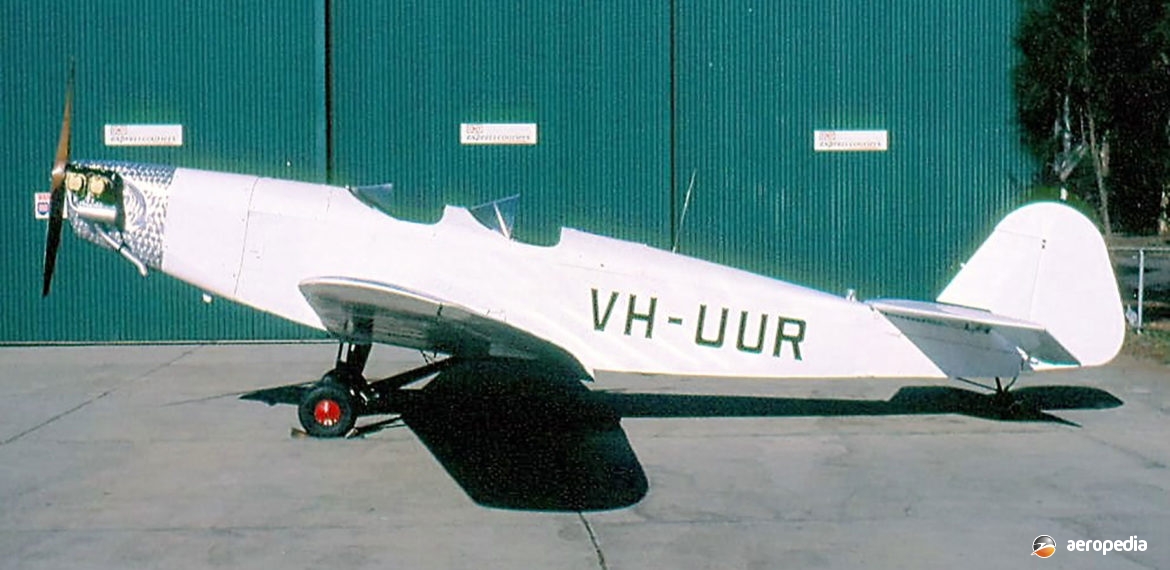Photograph:
Klemm Kl.25 VH-UUR (c/n 796) at Bankstown, NSW in November 1996 (David C Eyre)
Country of origin:
Germany
Description:
Two-seat light monoplane
Power Plant:
One 60 kw (80 hp) Hirth HM-60R four-cylinder inverted in-line air-cooled engine
Specifications:
- Wingspan: 13 m (42 ft 7½ in)
- Length: 7.5 m (24 ft 7 in)
- Height: 2.05 m (6 ft 8 in)
- Wing area: 19.97 m² (215 sq ft)
- Max speed: 160 km/h (99 mph)
- Cruising speed: 140 km/h (87 mph)
- Landing speed: 65 km/h (40 mph)
- Service ceiling: 3,800 m (12,464 m)
- Time to climb to 1,000 m (3,280 ft): 7.1 mins
- Range: 720 km (447 miles)
- Empty weight: 390 kg (858 lb)
- Loaded weight: 720 kg (1,584 lb)
History:
The Klemm Kl.25 series of light, low-wing cantilever monoplanes with an open cockpit was the first aircraft manufactured by Leicht Flugzeugbau Klemm. The Kl.25 first appeared in 1927 powered by a 34 kw (45 hp) Salmson 9AD radial engine. Continuous development during the following years resulted in the installation of a variety of engines, and the type was manufactured under licence in several countries, including the United Kingdom, where it was at first known as the BK Swallow, and later the BA Swallow.
The wing was built of two spruce spars with plywood covering. The fuselage was of rectangular section with a domed deck, with the entire box structure made of plywood. The main variant, and certainly the model to be built in the largest numbers, was the Kl.25d powered by a 60 kw (80 hp) Hirth in-line engine. Others were fitted with the Salmson radial and Argus AS8 engines.
About 600 examples were completed in Germany up to 1936 and were fitted with wheels, skis and floats, being operated by a variety of training organisations. Britain was supplied with 15 before World War II where they were fitted with British engines, and 28 were constructed by British Klemm Aeroplane Company as the BA Swallow. In the United States the Kl.25 and Kl.26 were constructed by Aeromarine-Klemm Company and about 120 were completed, this Company developing the design to suit the American market.
A small number of examples of the type has appeared on the Australian civil aircraft register. VH-ULU (c/n 131), a Kl.25-1, was first registered to Mr H C Ittershagen of West Subiaco, WA on 22 August 1929, at the time being fitted with a 30 kw (40 hp) Salmson radial engine. In 1929 it took part in the 3,848 km (2,390 miles) Western Australian Centenary Sydney to Perth air race between 29 September and 5 October. It then spent sometime as an advertising board for the sale of Lanz tractors, having the Company’s name painted on the forward fuselage. For a period in 1930 it was fitted with floats and operated a service to Rottnest Island from the Swan River. It was damaged in June 1932 when it struck a group of spectators at an air display and the registration lapsed on 16 January 1933.
VH-UNG (c/n 165), a Kl.25-1, was first registered on 10 March 1930 to Crude Oil Tractor Traders Ltd of West Subiaco, WA, a company run by Mr H C Ittershagen. It also had a Salmson radial engine. It was damaged on 31 January 1931 landing near Manjimup, WA and the registration lapsed. It resumed flying on 5 January 1933 and remained flying until 4 January 1934 when it was placed in storage until 1942. It flew for some little time thereafter but is thought to have been destroyed in a hangar fire in 1944.
VH-UUR (c/n 796), a Kl.25d-11, was once registered in Switzerland as HB-XAL. It was first registered to Father Frederick Ziegler of Einsiedeln, Switzerland on 5 August 1935 and was loaned to the Catholic Mission of the Holy Ghost at Alexishafen, Papua New Guinea. At this time it had a 56 kw (75 hp) Siemens Halske 13b radial engine and was flown by Willy Schaufhausen for pastoral care, passenger carriage, and light transport duties. It had a number of owners in Papua New Guinea, including T S Johnson on 2 September 1940 and Madang Aerial Transport Company on 7 October. It was damaged landing at Mt Hagen on 4 August 1941.
It was repaired and evacuated to Australia by T S Johnson due to the advancing Japanese forces but force landed north of Brisbane. It was impounded as the flight was unscheduled and the aircraft was placed in storage at Archerfield, QLD. It was restored to the register to Madang Aerial Transport Company on 27 June 1949 and flown by C B McLeod who, in 1950, fitted a Pobjoy Cataract radial engine. It was registered to Alex Oliver in Port Macquarie, NSW where it was based from June 1949, being fitted with a Continental C-85 engine in 1952 due to problems with spare parts. For some years it attended aviation events on the east coast where Mr Oliver demonstrated the aircraft’s ability to glide and fly slowly. In the 1980s it was loaned to and placed on display at Airworld, Wangaratta, VIC. In 1998 it was obtained by Sydney antique aircraft enthusiast, Roy Fox and restored at Bankstown, NSW. It has regularly been seen visiting eastern state airshows and fly-ins.

